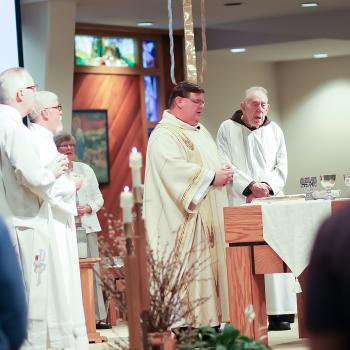“What to Preach on Ascension Day?”
Ascension Day is tomorrow! What to say?
I like to break mysteries down into who, what, when, and why, not always in that order.
The “what” of the Ascension is Jesus’ bodily rising into heaven and being welcomed by God and seated at God’s right hand. In thinking about precedent in the Hebrew Scriptures, the prophet Elijah comes to mind. See 2 Kings 2:8 for a dramatic exit worthy of Cecil B. DeMille, involving chariots of fire, horses of fire and a whirlwind. The other tradition that comes to mind is the intertestamental tradition reflected in 1 Enoch 42:2 that the Wisdom of God, having been rejected by the inhabitants of earth, retreats to heaven.
There are accounts of (or references to) Jesus’ Ascension in the traditional ending of Mark (16:19-20), Luke 24:50-51, John 20:17, and Acts 1:6-11. There is no mention of it in Matthew. In Acts Jesus promises the disciples that the power of the Paraclete(Holy Spirit) will come upon them and commissions them to witness to the good news to the ends of the earth.
He is then lifted up, a cloud takes him out of their sight, and 2 men in white robes appear and promise Jesus’ return via a cloud at some unspecified time. Other passages that speak of Jesus’ ascension and right hand seating are 1 Peter 3:21-22; Ephesians 4:7-13, and 1 Timothy 3:16. Ascension Day is a chief feast of the Christian Year, established in the 300’s. It is affirmed in the Nicene Creed and the Apostles’ Creed.
The “where” of the Ascension. Luke says Bethany. Acts says the Mount of Olives.
The when of the Ascension: In Luke it happens on Easter Sunday evening. In Acts it is 40 days after the Resurrection. Since Luke and Acts were written by the same person, this is odd. Maybe when Luke and Acts were broken into two, somebody tinkered with Luke? The number 40 reminds us of the 40 years the Israelites wandered in the wilderness and the 40 days Jesus spent in the desert.
The “why” of the Ascension. I think of every text as an attempt to answer someone’s question and then I ask myself, “What is the question?” In this case the Ascension counters the notion of various groups lumped under the umbrellas “docetists” (from the Greek dokeo which means “to seem”) who believed Jesus only appeared to be human, that his earthly body was a mere optical illusion. He didn’t really suffer on the cross. He was God appearing to be human. Other Gnostic groups (from Greek gnoeo) were dualistic, believing in a sharp divide between matter and spirit, with matter being evil and spirit being pure and incorruptible. A bodily Ascension offers a throw down to the docetists and the Gnostics. Jesus suffered, taught, and loved inseparably from a human body. He was resurrected as a spiritual body. He sticks around for 40 days, teaching in that mode and, when it’s time for farewell, he departs as a resurrected body, not a disembodied spirit. The ascending Jesus and the earthly Jesus are the same, fully human, fully divine.
So the “why” of the Ascension has everything to do with the “who” of the Ascension.
And that brings me to a story. When I was a little girl, maybe 4, my parents took me to church every week at at Baughman Memorial Methodist Church (we weren’t “United Methodists” yet) in New Cumberland, Pennsylvania, a little town on the Susquehanna River in Central Pennsylvania. It was a dark paneled church, built in the early twentieth century. On the back wall was a huge, 2 pane stained glass window. The left hand pane pictured Jesus kneeling in the Garden Gethsemane, his face anguished, a red blood-tear on his cheek. On sunny Sunday mornings, the sun would turn that tear into a glittering ruby. The right hand pane pictured Jesus ascending, his face serene and radiant, his hands at his sides, a faint, pinsized dot on each outstretched palm, his feet off the ground as he rose. Many questions ran through my four year old mind, among them “Who cries red tears?” and “Why isn’t he wearing shoes?”
I would stand on the pew, in my frilly church dress, my hands resting on the pew looking at the window, staring, first at oneside, then the other, for as much of the sermon as my mother would allow. Until she tugged on the hem of my dress and whispered “What are you looking at? Sit down, and pay attention.”
Finally one day I was able to put my confusion into words, “Why won’t that happy man help that sad man?”
She answered me as if it were the most obvious thing in the world, and maybe it is to everyone but me, but I don’t think so. She said, “They are the same man.”
I think that just might preach on Ascension Day.












